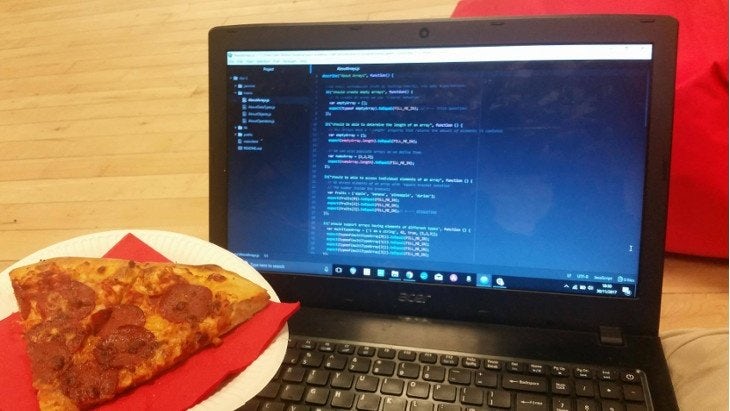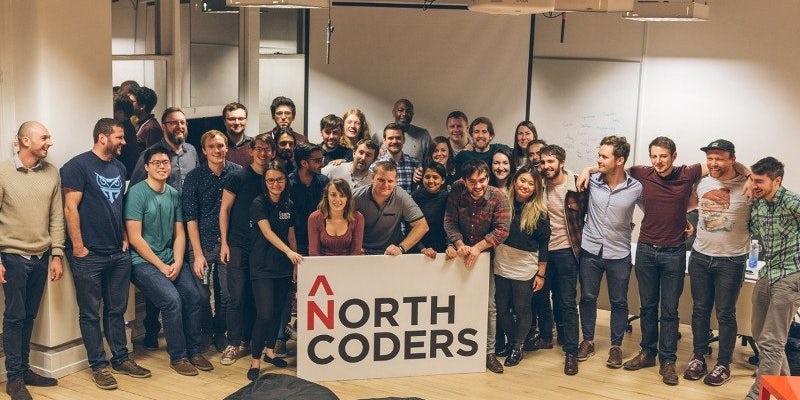Tech Education
Pizza and Primitives: Learning to Code at Introduction to Programming

So I don’t know that much about coding...
I’m Sam and I work at Northcoders as a Digital Marketing Apprentice. My job is mainly centered around running the Northcoders social media accounts and writing blogs posts (just like the one you’re reading right now).
Despite working at Northcoders my coding knowledge is woefully lacking, and after a while of working surrounded by code and needing a hand writing a few confusing code-related Tweets it became clear that I was going to have to learn more!
That is why I decided to do Introduction to Programming. Introduction to Programming is a beyond the basics evening course that is run across four sessions as a way of introducing beginners to coding and get a taste of what life at Northcoders is like.
Day One
On day one we’re given a warm welcome to everyone that will be helping us over the next two weeks, it’s a mix of Northcoders in Residence and current Cohort students, a lot of whom have done Introduction to Programming themselves. First off we learn about why Northcoders love JavaScript so much (they have good reasons), then the pizzas arrive and it’s time to start coding!
We familiarise ourselves with our browser's JavaScript console and begin to learn about primitive data types and how we can use them. Primitives are the most basic data types in JavaScript, there are:
>Strings, which store a series of characters such as "my name" or "my dog's name" and are denoted by speech marks
>Numbers, such as 12, 5, 6, 32 and interestingly enough the value ‘NaN’ (Not a Number) is a number..!
>Booleans, which represent either true or false
>Null represents no value
>Undefined tells us that a variable has not been assigned a value.
Day Two
Thursday starts off with a quick recap of what we learned last in our last session and a load more pizza! Then it’s time to dive back in! In this session it’s all about objects, arrays & data retrieval.
Objects are collections of properties where properties are associations between keys and values, they are great for storing information about, for example, people or cars. Arrays are used to store multiple values in a single variable such as a list of names. Things were still making sense at this point, I was starting to get suspicious.

Day Three
Day Three arrives, I start to question my liking of pizza and let out a loud groan as I struggle to get up off my beanbag to go get two more slices. The name of the game today is loops, which are a set of instructions used to repeat the same block of code until a specified condition is true or false.
Now I can write this definition with a fair bit of confidence but at the time loops made my brain feels like it was going to burst (I even made Google Chrome crash at one point because I put a ‘greater than’ symbol the wrong way) but despite this I felt confident enough to say “I really don’t understand this” and so the lead tutor Sam and I went through it together on a one to one basis, after a while of circling and re-circling the number three on the whiteboard and a lot of positive reinforcement things started to become a lot clearer!
Day Four
Functions are made up of a sequence of statements called the function body. Values (or arguments) can be passed to a function, and the function will return a value. This was the point that I did start to feel quite confident in what I was doing and even got a taste of what I assume pair programming is like (shoutout to Graham!).
Overall I will admit that there were times I felt like I was getting close to grasping a concept and all of a sudden I would feel it start to slip away, But I always felt comfortable and reassured enough to ask questions and push myself.
I definitely feel more confident in my abilities after doing the course.
It forced me to try and think in a way that I hadn’t for many years which was very interesting trying to get in to a problem-solving mindset. I think that if you’re interested in learning it’s definitely worth dipping your toes in the water, worst case scenario you’ll eat a lot of pizza and meet some new people... but I reckon you'll likely discover an exciting new hobby or even a career!
Interested in Introduction to programming? Find out more here.
Sam Shorter


